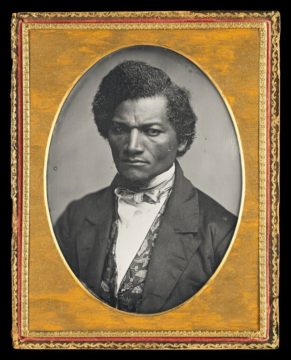William Thomas III in The New York Times:
 On Aug. 6, 1845, Frederick Douglass set sail on a speaking tour of England and Ireland to promote the cause of antislavery. He had just published “The Narrative of the Life of Frederick Douglass,” an instant best seller that, along with his powerful oratory, had made him a celebrity in the growing abolition movement. No sooner had he arrived in Britain, however, than Douglass began to realize that white abolitionists in Boston had been working to undermine him: Before he’d even left American shores, they had privately written his British hosts and impugned his motives and character.
On Aug. 6, 1845, Frederick Douglass set sail on a speaking tour of England and Ireland to promote the cause of antislavery. He had just published “The Narrative of the Life of Frederick Douglass,” an instant best seller that, along with his powerful oratory, had made him a celebrity in the growing abolition movement. No sooner had he arrived in Britain, however, than Douglass began to realize that white abolitionists in Boston had been working to undermine him: Before he’d even left American shores, they had privately written his British hosts and impugned his motives and character.
The author of these “sneaky,” condescending missives, Douglass soon discovered, was Maria Weston Chapman, a wealthy, well-connected and dedicated activist whose scornful nickname, “the Contessa,” stemmed from her imperious behind-the-scenes work with the leading abolitionist William Lloyd Garrison. In Linda Hirshman’s fresh, provocative and engrossing account of the abolition movement, Chapman was “the prime mover” in driving Douglass away from the avowedly nonpolitical Garrisonians and toward the overtly political wing of abolitionism led by Gerrit Smith, a wealthy white businessman in upstate New York. With brisk, elegant prose Hirshman lays bare “the casual racism of the privileged class” within Garrison’s abolitionist circle.
Setting out on her research, Hirshman initially considered Chapman a feminist hero whose significant role in the movement had long been overlooked. After all, Chapman raised enormous funds for abolition societies, edited Garrison’s newspaper, The Liberator, for years in his long absences, and carried on a massive petition campaign to end slavery. But when she read Chapman’s voluminous correspondence, Hirshman encountered the ugly personal rivalries and private politics at the center of a shaky alliance between the uncompromising Garrison and the ambitious and self-possessed Douglass.
More here. (Note: At least one post throughout the month of February will be devoted to Black History Month. The theme for 2022 is Black Health and Wellness)
